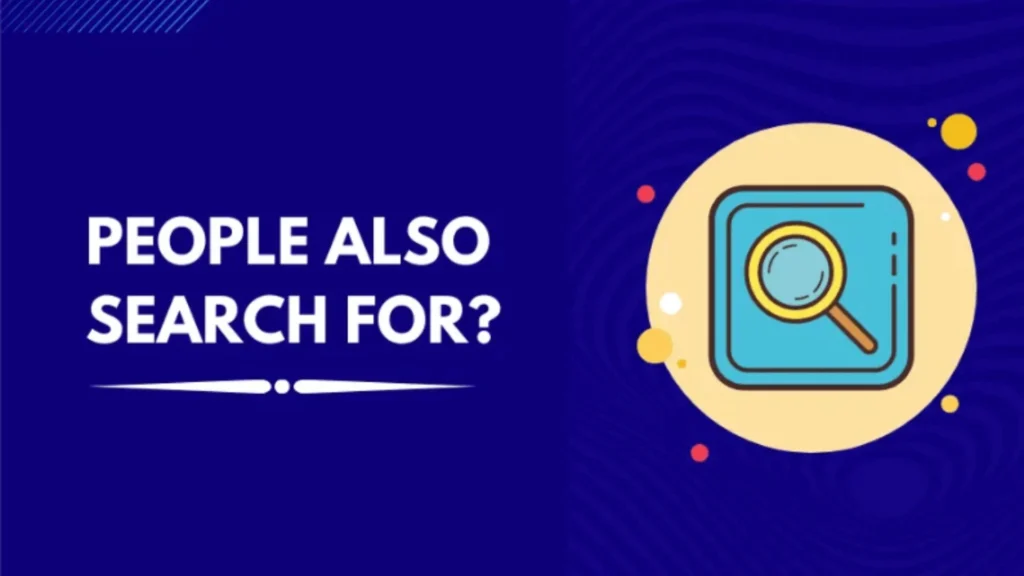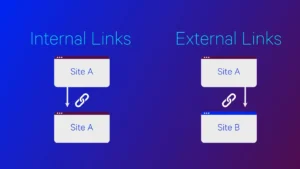Search engines are constantly changing. Once optional features are now essential for finding information online. The “People Also Search For” feature is one of them.
This blog will explain what People Also Search For (PASF) is and why it’s so important to grow online. You will also learn how to use it in your content strategy and challenges you may face in your journey.
What is “People Also Search For” (PASF)?
It is a feature on Google that appears when you search for something and then quickly returns to the main search page. Google displays a box under the link you just clicked when you return. This box shows related things that other people search for after they’ve made the exact search you did.
Such suggestions are based on real people’s search queries and show the next steps or different approaches people take to find information. But PASF is special even though it looks like a related search. It’s because this only appears after you’ve clicked a result and gone back. It’s meant to help you find what you need when the first link wasn’t what you were looking for.
How PASF Differs from Other SERP Features
| Feature | What it Shows | Where it Appears | How It’s Different from PASF |
| People Also Ask (PAA) | Questions related to your query can be expanded for answers. | It’s usually seen on search results pages or in the middle. | PAA shows you questions people ask before they find an answer. While PASF shows you more specific searches people make after a result isn’t satisfactory. |
| Related Searches | This includes searches related to your original query which appear at the bottom of the search results page. | It appears at page end after scrolling through top results. | Related searches are usually more general. PASF is unique because it only appears after a user clicks on a search result and then quickly returns to the search page. This means PASF offers more specific or refined search terms if the first link didn’t help. |
| Search Suggestions | Google suggests what you want to search for next as you type. | This feature appears in the search box before you finish typing your search query. | Autocomplete works before you search. PASF appears after you’ve already searched. It assists you at various stages of your search. |
Why It Is Important for SEO and Content Strategy
It is more than just a convenient Google feature for users. It’s also crucial for content creators and professionals in SEO. Here are some main reasons why:
- Audience Insights
PASF suggestions come from what real people search for. This shows you how a person’s intent changes as they search. If many people search for “X” and then click to search for “Y” then it shows that “Y” is a key topic.
- Keyword Discovery
Many of the suggestions are more specific and detailed since these are refined queries. Such terms are often less competitive but are highly relevant and can lead to more conversions. So targeting them can help you capture highly motivated searchers.
- Discovering Content Gaps
PASF shows what searchers didn’t find in the content they just read. It gives you ideas for new content that can answer such questions. Your article might explain “What is X” very well. But people might then search for “How does X compare to Y” or “X’s benefits and disadvantages.” It provides opportunities for you to create new and relevant content.
- Building Topical Authority
You can develop a content strategy that covers multiple aspects of a topic on your website by identifying groups of related searches. Google sees your site as a trusted expert on that topic when you do this. This improves your chances of ranking for a broader range of related keywords.
- Enhancing User Experience
Using standard search terms and answering related questions can make your content more helpful for readers. This keeps them on your page longer and prevents them from leaving quickly. It also allows you to organise your content with better headings and FAQ sections so it matches perfectly with people’s search intent.
- Improved Search Rankings
Using PASF data helps you improve your content so it is more likely to appear in search results for related and more specific searches. You can still rank well for many specific searches even if you can’t rank number one for a general keyword. Combining all such searches can bring a lot of visitors to your site.
- Market Edge
Many websites focus on general keywords. But a few use PASF to improve their content. You can get noticed in areas where your competitors are not if you use this information to create content that answers related questions.
How People Also Search For Really Works?
You should know how Google generates such suggestions to use this feature effectively. Experts have identified several factors that appear to influence it even though Google keeps exact details private.
- User Behaviour
Google understands that its content might not be what the user was looking for when he click on a search result and then quickly returns to the search page. This action triggers the PASF suggestions which are meant to provide more relatable options.
- Personalized Factors
It’s suggestions can vary based on your device and previous searches just like many other search results. This is because Google tries to personalise suggestions. This means that what you see might be different from what others see.
- Query Similarity and Frequency
The more often people search for one thing and then another the more likely that second search will show up in PASF. So how frequently people do a specific search matters in short. This is why you will see common searches appear more often.
- Topical Relevance
Your suggestions are always related to the original search and are not random. Google uses technology to find relevant topics related to your search. This is how it shows you ideas that make sense.
- Search Page Layout
Elements like featured snippets and People Also Ask boxes might interact with People Also Search For feature. The content of on top search results can also affect what PASF shows. So it might suggest it as a next step if leading content doesn’t fully cover a related topic.
How To Find People Also Search For Keywords?
You don’t need expensive tools or special access to find PASF insights. And here’s how you can do it:
- Manual SERP Observation
Start by searching for your main keyword on Google. Click on a search result but don’t stay on the page for long. Quickly press the back button to return to the search results page. If you do this fast enough then Google might show you “People Also Search For” suggestions under that result.
- Using SEO Tools for PASF
Many SEO tools can help you find data. Semrush offers tools for researching topics and analysing questions people ask. Other tools like Nightwatch also provide features or guides to help you use it’s insights.
- Using Analytics and Search Console
Using Google search console allows you to find what people search to get to your site. Look for queries with a high bounce rate or short time on page. Such searches could be similar to suggestions.
- Using Question and Keyword Tools
Tools like AlsoAsked show you a visual map of what people ask in related searches. This helps you see how different questions are connected even if it’s not the exact PASF box. You can then use such questions to check the search results yourself.
How to Use People Also Search For Content Strategy?
Knowing about it is helpful. But using it well is a different story. Here are some simple steps you can follow for practical use:
- Keyword Research and Content Ideation
Begin your content plan with a primary keyword. Then use related suggestions to explore new topics or sections. You can also use them to create a group of related content. So if your main topic is “digital marketing trends” then People Also Search For feature might suggest related ideas like “trends for small businesses” or “AI trends”. Each of these ideas could even become a new blog post.
- Update Existing Content
You can expand your content by adding sections that answer related questions from PASF. You can also create an FAQ section at the end of your articles using suggestions as questions. Many people quickly look over such sections. So answering it can make them stay on your page longer.
- Enhancing Internal Links
Use PASF suggestions to find opportunities for internal links. If a suggestion is on a topic you’ve already covered then you should link to that page. This helps users find what they need and boosts your site’s authority on related issues.
- Using Keywords for On-Page SEO
Naturally include keywords and phrases in your headings and meta descriptions when they are relevant. You can also use them in the main body of your content where it makes sense to answer questions people are searching for. Don’t overuse them and focus on creating quality content.
- Developing Content Pillars
Use a main pillar page to cover your primary topic in detail. Then create separate articles called supporting content that go into more detail on specific topics suggested by it. You can also make content hubs with it.
- Keeping Up with Changes
PASF suggestions change over time as people’s search habits shift and new topics become popular. Regularly check your content plan and keyword tracking to stay updated.
You can also use Google Search Console and analytics to see which of your pages get traffic from searches that are like PASF suggestions. Then you can update that content.
Common Mistakes to Avoid
PASF is a powerful tool. But it’s essential to use it correctly. And here are some guidelines to help you.
- Stay Relevant
Not every suggestion will fit your audience or content goals. So make sure only to use ones that make sense for your specific topic and what you can honestly and expertly write about. This confirms your content stays focused and valuable.
- Avoid Keyword Stuffing
Don’t unnecessarily force keywords into your content. It’s because your main goal is to help your audience. If a suggested topic doesn’t fit naturally then it’s better to leave it out than lower your content quality.
- Balance Your Content
Expanding your content with PASF topics is helpful. But avoid adding too many irrelevant ideas which can make your content less focused. Instead, choose topics that fit well with your main subject.
- Choose Keywords with Less Competition
Some PASF keywords can still be competitive even though many of them are specific. Use a tool to see how hard it is to rank for such keywords and if you can succeed. This strategic approach ensures your efforts are productive and result in more traffic.
- Prioritize User Journey
Users will leave your website quickly and it will rank lower by Google if you create poor quality content that is not helpful. This will cause your bounce rate to go up and your visibility to go down. And your site will eventually lose authority and visitors.
- Keep Your Content Fresh
Search habits of people change with time. What was popular a year ago might not be relevant now. Checking your content regularly is helpful. This keeps your content fresh and relevant for your audience which can also improve its ranking over time.
How To Track Your Performance
Here is how to check whether using People Also Search For is working or not:
- See where you are ranking for the new questions you answered.
- How much traffic do you get on your pages after you added this new content.
- To check if people are spending more time on your content or see how long they stay on your page.
- See if you are linking to your new content more often from other pages on your website.
- Check if your page is showing up in special Google search boxes like featured snippets. It will help you check how good your answer was.
- Check if your new content is helping you reach your goals such as getting more sales.
Emerging Trends in People Also Search For
Here are some important things to know about it as of 2025:
- Google is always changing where and how these suggestions appear on mobile and desktops.
- Google is always changing how its search features like People Also Search For and People Also Ask work. It’s important to stay updated on such changes.
- More online tools now show extra questions people ask. It’s because the goal now is to give a complete answer and not just to rank for one keyword.
- There is a lot of content available on different topics nowadays. So a good way to stand out is to cover PASF topics well. Content that isn’t helpful is no longer good enough.
Your Step-by-Step PASF Guide
Follow steps mentioned below to implement a proper content strategy:
Step 1: Define Your Main Topics
Choose main topics you want your website to focus on first. Make sure subjects you choose are important to your readers. This will help you create content that your audience actually wants to read.
Step 2: Find Keywords for Each Topic
You can find keywords for each topic in two main ways. You can first search online and click on a result. You will see a section called “People Also Search For” if you return to the search page. You should carefully write down such suggestions. You can also use a search tool like Semrush to find related questions and keywords.
Step 3: Prioritize Your Queries
You must now decide which keywords are most important by considering their relevancy to your topic. You should also ensure you can answer your question well and that your keywords will help your brand grow.
Step 4: Plan Your Content
Decide if your chosen content should be a new article or page on your site or part of an FAQ section. A good rule is to create a new page for complex topics and use FAQ for straight and simple questions.
Step 5: Keep Your Content Fresh
Use keywords you chose as headings in your content. Ensure that you respond to every question in a clear way and in an easy to scan format by people reading your text. This facilitates easy search of information by the visitors and the search engines.
Step 6: Connect Your Content
Make sure to link your new content to other relevant pages on your site. This helps both people and search engines find all your related content. It also shows Google which pages are most important. This leads to higher rankings and more traffic over time.
Step 7: Enhance User Experience
Ensure that your images and page titles are optimized. You can also include items like tables to make it more easy and understandable. This also enhances your user experience which is a crucial ranking factor.
Step 8: Check Your Progress
Use tools like Google search console to see if your new content is doing well. Update your best pages by adding more information or fixing any gaps. This helps your website stay fresh and relevant and which can improve your rankings over time.
Step 9: Stay Updated
You should check your main topics again from time to time since people’s search habits change. This helps you find new questions people are asking and keep your content fresh. Make this a regular part of your content strategy.
Conclusion
Google’s People Also Search For feature is more than just a list of related searches. It shows you what’s on people’s minds. It’s a great tool to find out what your audience truly wants to know since every suggestion comes from real searches.
PASF allows you to choose better keywords and become a greater expert on a topic for marketers and businesses. And you rank higher and give your readers a better experience by adding such questions to your content.
FAQs
Q1. What does “People Also Search For” mean on Google?
It is a feature provided by Google that shows related searches after users click a result and return to SERP that reflects common queries.
Q2. How is PASF different from People Also Ask?
PASF shows related searches while PAA lists related questions with answers that you can click on right on search results.
Q3. Why is PASF important for SEO?
It shows what real users search for and guides you on how to group topics to improve your ranking and audience engagement.
Q4. How can I use PASF in my content strategy?
Use PASF questions as keywords or subtopics. Then create new content and link it together to fully cover all related questions users have.
Also Read:
How Digital Marketing Can Increase Student Admissions






